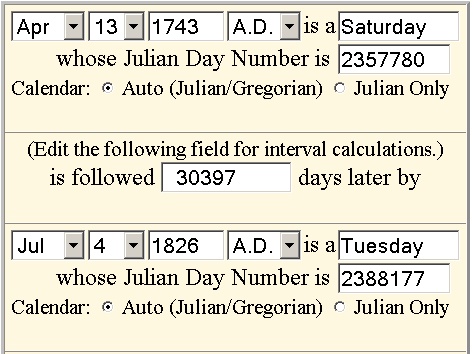 Click here
Click here Identical names are often applied to different things and to different people. The resulting non-unique nature of these names means that finding a particular one among the others sometimes becomes impossible. The problem arises because of the difficulty of indexing things that do not have unique names. Many attempts have been made to facilitate finding things and information, such as the Dewey Decimal System, the Library of Congress (LOC) subject headings and Internet search engines. But problems are inevitable because of the arbitrariness of names being applied to a multiplicity of things and because of the ambiguities forced upon indexing systems themselves.
The system named Juliana indexes all things, including authors and books, by tagging them with pre-existing and easily identifiable temporal and spatial data. For example:
Jefferson, Thomas: (birth) 2357780. +38.0142 -78.3978 (death) 2388177. +38.0042 -78.4563
The first number after the type of tag identifier (birth) is a Julian Day number. The Julian Day number is derived from astronomy and has been used for hundreds of years for precisely locating stars. It is used in the Juliana index because it is standardized for all historical time without any complications such as the local language, or the local calendar being used. It is freely available and it gives compact results with infinitely definable precision.
The second group of tagged numbers are equally specific but refer to spacial locations. They are based on absolutely standardized longitude and latitude numbers in decimal notation. These location numbers are added to the Julian time notation numbers to give an exact time and location of the creation of the item being observed. The result is accurate to one second in all historical time and to one meter on the surface of the earth. This degree of accuracy is achieved by using about thirty standard Arabic numerals. The Juliana number can be associated with the the birth any specific person such as an author or with the creation of any specific thing such as a book. Thus, with the Julian date and the latitude, longitude altitude number anything becomes disambiguated for all time from everything else. Any item, no matter how close in time and space its creation to another, can be perfectly separated from all others by simply adding clarifying temporal and spatial digits.
The closer the searcher comes to the target material in time and space the more specific and recognizable become the results presented. The method is to link together specified terms, such as (author), (date) and (location) using the XML tagging method. This can be almost wholly accomplished by existing computers and existing data sets to compile a central Juliana database index for all authors, books and later for all other physical objects as well.
When using this Juliana method the first term associated with an author would be the time and place of birth. The author would be listed by birth date (author-birth Julian-day to the moment) followed by author birth place (author birth latitude-longitude-altitude to the precision known).
To illustrate the ease of creating the basic data here is my birth date and place in traditional format followed by the Juliana format.
A typical entry - Charles LeRoy Scamahorn: October 1, 1935 - 5:57 PM, 707 N. Cedar Street, Spokane, Spokane, Washington, USA.
Juliana in decimal latitude - Scamahorn, Charles LeRoy: (birth) 2428077.58125 +47.6637 -117.4328 570m
In Juliana there are two basic dimensions. Time in days and space in degrees. However in standard notation there are about "seventeen" basic changes of the base format to locate an exact time and place ie.. Month, day, year, AD, hour, minute, second, decimal second, AM/PM and street number, orientation, street name, city, county, state, country, continent/ocean and possibly a required zip code. Those are in a well defined place in America and in the English language but when you go to the suburbs of Tokyo, Japan, or the wilds in the mountains of Tibet you would be lost. Either there were too many complex local markers in foreign language and foreign writing system or none whatsoever. Juliana gets you to the same place at the same time every time everywhere on earth throughout all historical time. If its the birth place of Thomas Jefferson or The Dali Lama you can go right to it on a map, or in physical reality. The place, person or thing is disambiguated from everything else for all time and it is then easily linked to relevant data of your choosing.
Obviously there will be many ambiguities at first while the basic database is being assembled. However, by using this Juliana method the data can be separated, sorted and clarified to the best fit and automatically cross-indexed in the database to the alternate results. One of the beauties of the Juliana system is that a new analysis by a remote searcher using the same or similar input data would come up with similar or even identical numbers associated with the given item or person. Variations of input data could then be easily found on the central database and rectified and stored with the various alternate results. Everyone and everything has a date of creation and a location of creation and the combination the two is unique; far more unique in fact than their arbitrarily assigned names, arbitrarily assigned Dewey decimal numbers or arbitrarily assigned LOC numbers or questionably found Google presentations. Furthermore, these two things required for accurately identifying time and space are freely available with great accuracy from: Four Mil Lab for current Julian Day time, US Navy Julian Date for conversions and Google Earth. When Juliana is fully implemented these items would be presented by one program on one page with other helps for easy use.
Because this system is based on the old Julian Day astronomy system a good name for it is Julian Day Authority Earth Metric Coordinated File System or Julian-A for a shorter terminology or to coin a new term which is unique and specific to this new system - Juliana.
The entry boxes below have Thomas Jefferson's birth and death dates entered and when the Julian Day Number box was clicked the Julian Day was computed.
 Click here
Click here Below is the entry page of Google Maps, a standardized accurate latitude and longitude photo based map which is interactive with the computer user.

Below is an example of the Juliana method using Thomas Jefferson and his document the Declaration of Independence.
Thomas Jefferson was born 13 April 1743 in Shadwell, VA.
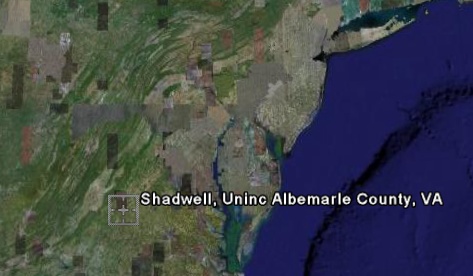
This location converted to latitude / longitude is +38.0142 -78.3978.
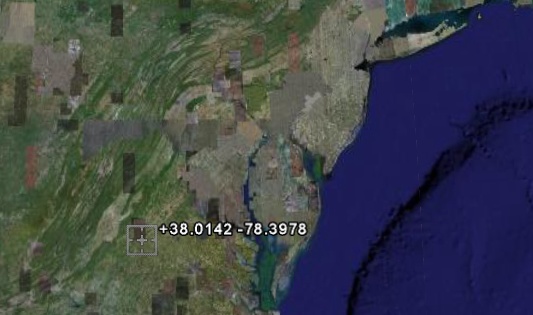
This calculated location is automatically done by Google Earth and once the picture or map is displayed the location of the mouse pointer is shown on screen to a high degree of precision.
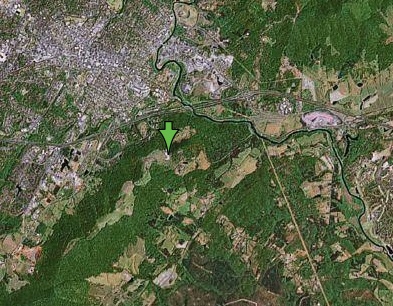
This Google Map has an arrow pointing to Montecello, Jefferson's birth home now vanished is somewhere in the picture; it was called Shadwell, a few miles to the east of Montecello.
He died July 4, 1826 (aged 83) Charlottesville, VA. This would be added to that plain text data like this (Jefferson, Thomas: birth JD2357780. +38.0142 -78.3978). That short string of numbers gives a publicly creatable and publicly identifiable identification to that exact person without revealing anything else about them. This information is already public information readily available and so having it on a database is not infringing on their privacy or revealing anything new about their personal information or giving access to their passwords or any other private information. But it does permit identifying them uniquely from all other people, places and things whatsoever. A second key string would be the date and place of death. For Thomas Jefferson this would be his death date and place (Jefferson, Thomas: death JD2388177 +38.0042 -78.4563). A reverse directory could be created where the birth date, death date or location of birth, or death could be presented and the maping would list the things that happened there at that time.
A complete birth-death listing for him in plain text would look like:
Jefferson, Thomas: born 13 April 1743, Shadwell, VA - died July 4, 1826, Charlottesville, VA
and in the new Julian Date format like this:
(Jefferson, Thomas: birth JD2357780. +38.0142 -78.3978 death JD2388177 +38.0042 -78.4563)
He lived 30,398 which is found by simple subraction of the days. Or 83.225 years found by dividing the days by 365.25. The data is the same in this new form but is more standardized and thus more readily searched and manipulated by computer and by human. The other traditional formats being highly variable in their presentation from one venu to another.

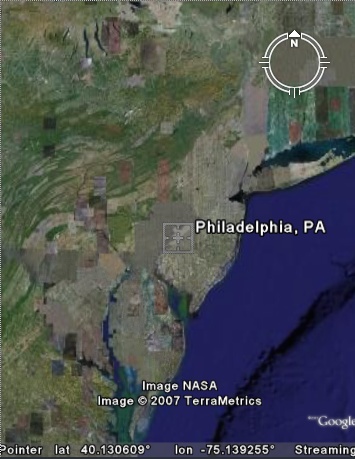
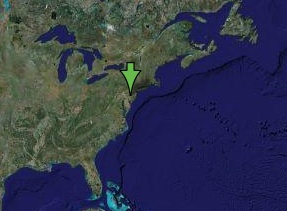
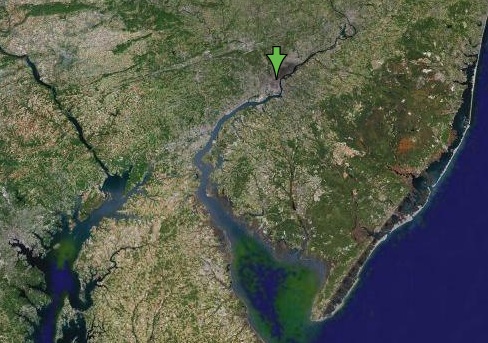
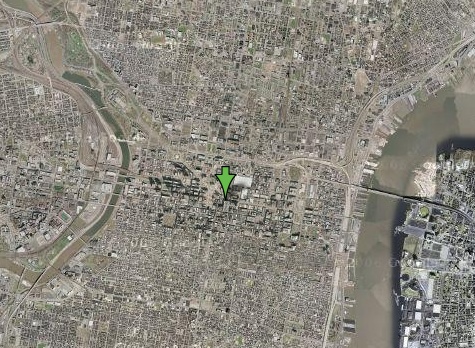
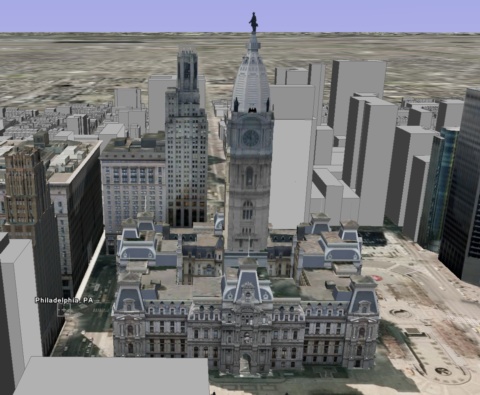


Charles LeRoy Scamahorn, October 1, 1935 - 5:57 PM, 707 N. Cedar, Spokane, WA, USA.
Juliana(Scamahorn, Charles LeRoy: birth JD 2428077.58125 latlon+47.6637-117.4328) [70digits]
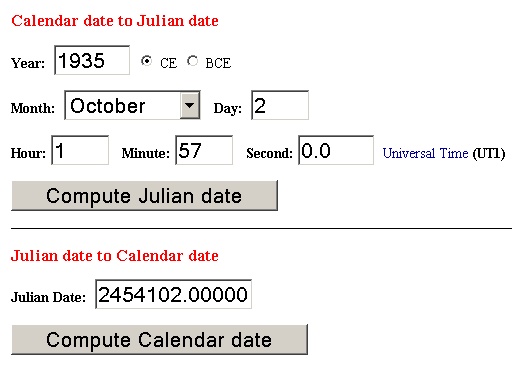 Click here to get a US Navy Julian Date to the 1/10th second but convert target location time to Universal Time first.
Click here to get a US Navy Julian Date to the 1/10th second but convert target location time to Universal Time first.